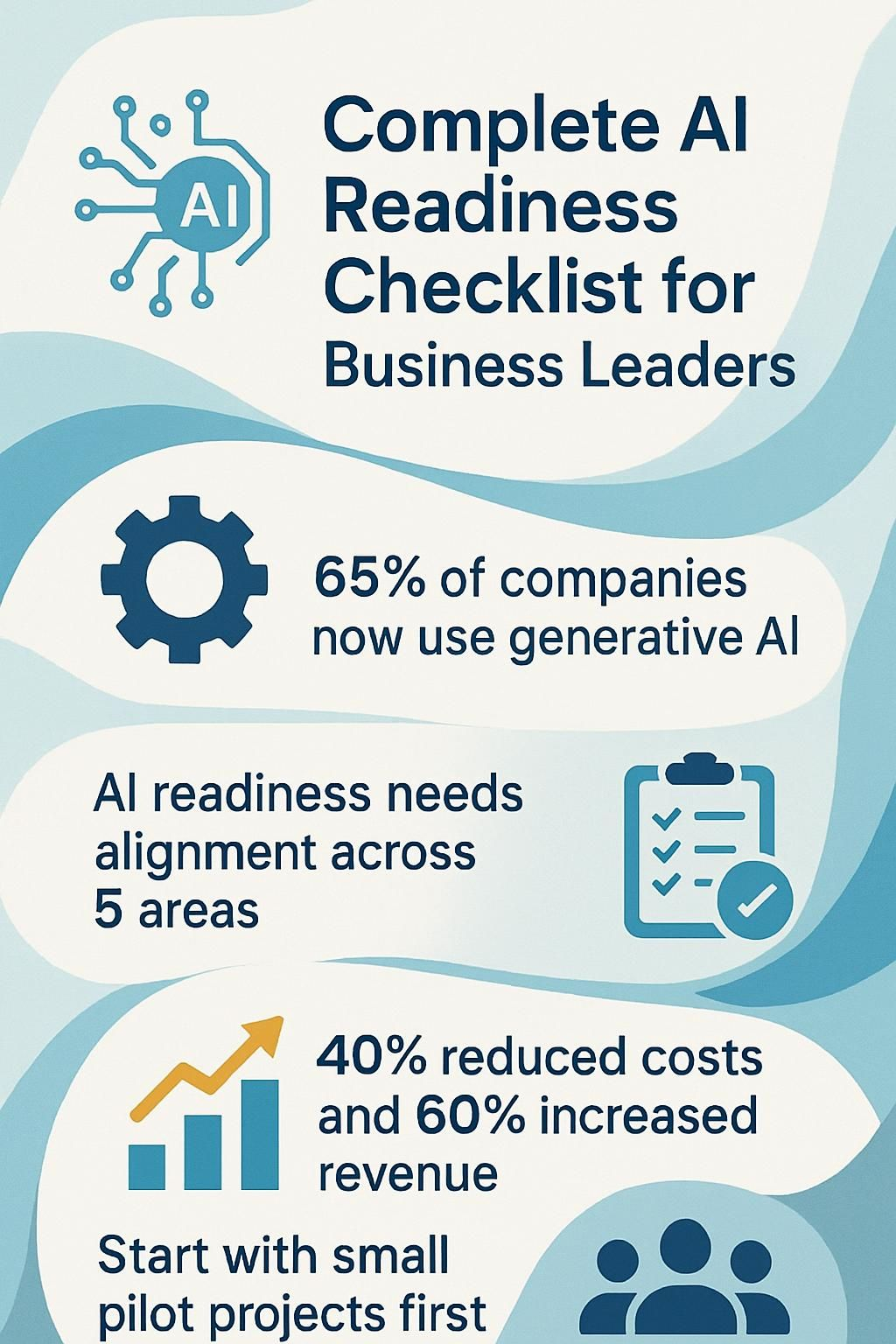Complete AI Readiness Checklist for Business Leaders


Understanding AI Integration

AI readiness refers to how prepared your organization is to adopt and benefit from artificial intelligence technologies. Nearly 75% of businesses have already integrated AI into at least one business function, with generative AI usage doubling to 65% among survey respondents in the past year according to McKinsey's 2024 survey.
The Intel model breaks AI readiness into three phases: foundational, operational, and transformational readiness. Each phase builds on the previous one to create a solid framework for successful AI adoption.
Business leaders face a critical challenge today. Your competitors are racing to implement AI while you might still be figuring out if your company has the right data, infrastructure, or talent to make it work.
As an AI & Automation Strategist who has built over 750 workflows and generated $200M for partners through problem-first automation, I have seen direct evidence of how proper preparation makes all the difference between AI success and expensive failure.
WorkflowGuide.com helps organizations become AI confident by aligning AI adoption with core Business Strategy. The firm's approach focuses on Digital Transformation, Workforce Training, and Change Management to build true Organizational Readiness.
The path to AI readiness isn't just about buying fancy tools. It requires leadership commitment, quality data, solid tech infrastructure, trained staff, and smart financial planning.
Over half of employees currently feel unprepared to work with AI technologies, highlighting a major skills gap that needs addressing before implementation.
This checklist will guide you through assessing your organization's readiness across all key areas. You'll learn how to evaluate your data quality, craft an implementation strategy, measure success, and overcome common roadblocks.
The goal isn't to replace human work but to enhance it through thoughtful AI integration.
Key Takeaways
- 65% of companies now use generative AI, double the amount from last year, showing rapid adoption despite many businesses struggling to benefit from their AI investments.
- AI readiness requires alignment across five key areas: leadership commitment, data quality, technological infrastructure, workforce skills, and proper financial planning.
- Nearly 75% of companies have adopted AI in at least one business function, but over half of employees feel unprepared to work with these new tools.
- Companies that successfully implement AI see tangible benefits - 40% reduced costs while 60% increased revenue, according to McKinsey's 2023 survey.
- Start with small pilot projects that deliver quick wins before scaling AI across your organization, and always measure both technical success and business impact.

Understanding AI Readiness

AI readiness boils down to your company's ability to actually benefit from artificial intelligence, not just install fancy tech that collects dust. Think of it like buying a high-end gaming PC but having no idea how to use anything beyond Solitaire.
The Intel model breaks this readiness into three clear stages: foundational (getting your basics sorted), operational (making AI work in daily tasks), and transformational (completely rethinking your business with AI).
Recent McKinsey data shows nearly 75% of companies have adopted AI in at least one business function, with generative AI use doubling to 65% in just the past year.
Yet despite this rush to adopt, most organizations face a critical gap. Over half of employees feel completely unprepared to work with these new AI tools. This creates a digital transformation traffic jam where companies invest in technology that their teams can't effectively use.
Your AI readiness isn't just about servers and software; it's about creating a complete ecosystem where data, technology, people, and processes align toward clear business goals. The question isn't whether you should adopt AI, but how prepared your organization is to make it truly valuable rather than just another tech buzzword on your website.
Let's explore why this readiness matters so much for business leaders looking to stay competitive.
Why AI Readiness is Crucial for Business Leaders
Business leaders face a stark choice today: adapt to AI or fall behind competitors. The numbers tell a clear story. A 2023 McKinsey survey revealed that nearly 40% of companies using AI cut costs while 60% boosted revenue.
This isn't just about staying current with tech trends; it's about survival in a data-driven marketplace. Leaders who prepare for AI gain the tools to automate routine tasks, freeing their teams to tackle strategic work that humans do best.
Think of AI readiness as your business's immune system, protecting against disruption while creating new growth paths.
AI readiness isn't about replacing humans with robots; it's about removing the robot work from humans. - Reuben Smith
Data quality makes or breaks your AI journey. Many business owners jump into AI without checking if their data can support it, like trying to build a house on quicksand. Leadership commitment also drives success, as half-hearted AI projects rarely deliver results.
Your team needs clear signals that this matters. The tech infrastructure assessment comes next, making sure your systems can handle new AI tools without crashing. Let's explore these key components in detail to build your complete AI readiness checklist.
Key Components of an AI Readiness Checklist
The AI Readiness Checklist breaks down into five critical areas that business leaders must tackle before jumping into implementation - skip any of these and you're basically trying to build a rocket with duct tape and wishful thinking.
Keep reading to discover how each component can make or break your AI journey.
Want To Be In The Inner AI Circle?
We deliver great actionable content in bite sized chunks to your email. No Flim Flam just great content.

Leadership Commitment and Vision
AI adoption starts at the top. Business leaders must grab the steering wheel and chart a clear course for AI in their companies. Think of it like being the captain of the Starship Enterprise, you need to know where you're going before you can say "engage." Leaders who grasp AI technologies create a ripple effect of readiness throughout their teams.
I have seen countless projects crash and burn because the boss thought AI was just fancy Excel macros.
Resource allocation isn't just about throwing money at shiny new tech toys. Strategic vision requires leaders to put their budget where their mouth is. Your team watches what you fund, not what you say in quarterly meetings.
When leadership actively promotes AI's benefits, everyone gets on board faster. This shared understanding transforms skeptics into champions. Just like learning to code, the first step is admitting you don't know everything, but committing to figure it out anyway.
Data Quality and Accessibility
Garbage in, garbage out. This old programming adage hits the bullseye when talking about AI systems. Your fancy new AI tools will produce junk results if fed with messy, incomplete data.
High-quality data forms the backbone of any successful AI implementation. Business leaders must audit their current data for accuracy, consistency, and relevance before jumping on the AI bandwagon.
I have seen companies waste six figures on AI solutions only to discover their data resembled a teenager's bedroom, scattered and disorganized.
Data quality isn't just an IT concern, it's the foundation upon which your entire AI strategy stands or falls. - Reuben Smith
Data accessibility presents another critical hurdle. Your valuable data might sit locked in legacy systems or exist in formats that AI tools can't process. Creating clear data pipelines and breaking down departmental data silos should top your priority list.
Many organizations maintain strict data access controls for security, which makes perfect sense. But these same controls can block AI systems from accessing the information they need to function properly.
Smart leaders balance security concerns with practical access requirements. The next step after addressing data quality involves building the right technological infrastructure to support your AI ambitions.
Technological Infrastructure Assessment
While data quality forms the foundation of AI readiness, your technological infrastructure determines how effectively you can deploy AI solutions. Think of your tech stack as the nervous system that will carry AI signals throughout your business body.
A proper infrastructure assessment maps out your current systems, identifies compatibility issues, and spots potential bottlenecks before they cause headaches. Many business leaders skip this step and jump straight to AI implementation, which is like trying to install solar panels on a roof that can't support the weight.
Your infrastructure analysis should cover both hardware and software capabilities against your AI goals. This gap analysis reveals what you have versus what you need for successful AI integration.
I have seen too many companies invest in fancy AI tools only to discover their legacy systems can't talk to the new technology. A strategic roadmap should outline necessary upgrades, integration points, and a realistic timeline for implementation.
The best assessments also include performance metrics to track how well your infrastructure supports AI initiatives after launch. Your technology evaluation isn't just a one-time event but part of a continuous improvement cycle that aligns your tech capabilities with evolving business needs.
Workforce Skills and Training
Your team's AI skills gap might be bigger than you think. A sobering fact: over half of today's employees feel unprepared to work with AI technologies. This creates a digital literacy canyon that needs bridging before any fancy AI implementation can succeed.
Think of upskilling your workforce like upgrading your gaming character before the boss battle, not an optional side quest. Smart business leaders invest in continuous learning through workshops, online courses, and hands-on projects that transform tech anxiety into confidence.
The best training programs tackle both technical skills and the natural resistance to change. I have seen companies roll out million-dollar AI systems only to watch them collect dust because staff weren't properly trained.
Your workforce readiness strategy should mix formal education with practical application. Give your team space to experiment with new tools in low-risk scenarios. Professional development isn't just about teaching new buttons to push; it's about creating a culture where technology adoption becomes second nature.
The companies that thrive with AI don't just buy better tech, they build better teams.
Budget and Financial Planning for AI
Training your team for AI adoption connects directly to your wallet. Smart money moves make or break AI projects, and most businesses crash because they skip proper financial planning.
Your AI budget needs to cover more than just software costs. It must include talent acquisition, ongoing training, and tech upgrades that support your AI systems.
Money talks in AI projects, so listen carefully. Resource allocation drives successful implementation, with proper funding enabling both pilot testing and scaling. Many leaders get starry-eyed about AI capabilities but forget to set clear ROI metrics.
Track your progress with specific financial goals like reduced operational costs or increased sales conversion rates. I have seen companies blow their entire tech budget on fancy AI tools that collect dust because they didn't plan for the skilled people needed to run them.
Smart financial forecasting helps you avoid this common pitfall while creating a sustainable investment strategy for long-term AI growth.
Data Quality Assessment for AI Implementation
- Conduct a data inventory to identify all available data sources across your organization. Map what you have against what your AI project needs.
- Check your data accuracy by validating it against trusted sources or through manual spot-checks. Bad data creates bad AI outcomes, like trying to navigate with a map from 1950.
- Assess data completeness by looking for missing values, incomplete records, or gaps in time series data. AI models hate Swiss cheese data with holes everywhere.
- Evaluate data consistency across different systems and departments. Conflicting information confuses AI just like it confuses humans.
- Measure data timeliness to confirm your information isn't outdated. Yesterday's weather forecast doesn't help you dress for today.
- Implement data cleansing procedures to fix errors, remove duplicates, and standardize formats. Think of it as digital housekeeping for your AI.
- Establish data governance policies that define ownership, access rights, and usage guidelines. Good fences make good AI neighbors.
- Test data reliability through repeated sampling and validation. Your AI needs steady data it can count on.
- Review data compliance with relevant regulations like GDPR, HIPAA, or industry standards. Legal trouble ruins the AI party fast.
- Create data validation workflows to catch problems before they reach your AI systems. An ounce of prevention beats a pound of algorithmic cure.
- Document your data lineage to track where information comes from and how it transforms. Know your data's life story.
- Set up data quality metrics and KPIs to track improvement over time. What gets measured gets managed.
- Build a data dictionary that explains what each field means and how it should be used. Translation guides prevent AI misunderstandings.
- Analyze data relevance to your specific AI use cases and business goals. Not all data deserves a seat at your AI table.
- Plan for ongoing data maintenance rather than one-time cleanup. Data quality is a marathon, not a sprint.
Crafting an AI Implementation Strategy
- Set clear business goals for your AI projects, like cutting customer service response times by 30% or reducing inventory costs by 15%.
- Map your AI initiatives to specific business problems rather than adopting technology just because it's cool (though it is pretty cool).
- Start small with pilot projects that deliver quick wins and build momentum for bigger AI initiatives.
- Create a realistic timeline with milestones that account for learning curves and unexpected challenges.
- Assign an AI champion or task force responsible for driving implementation forward when things get tough.
- Develop a data governance framework that balances innovation with privacy and security requirements.
- Budget for both initial implementation costs and ongoing maintenance of your AI systems.
- Plan for integration with existing systems to avoid creating tech silos that nobody can talk to each other.
- Design feedback loops to gather insights from users and customers about AI performance.
- Build a change management plan that addresses fears and resistance from staff who worry robots might steal their jobs.
- Draft communication strategies to keep stakeholders informed about progress, setbacks, and wins.
- Include continuous learning opportunities so your team can grow alongside your AI capabilities.
- Create metrics to track both technical success (is the AI working?) and business impact (is it making money?).
- Establish ethical guidelines for AI use that align with your company values and industry regulations.
- Plan for scaling successful AI initiatives across departments or locations once they prove valuable.
Measuring Success After AI Integration
Your AI strategy needs clear success metrics just like a video game needs a scoring system. Moving from planning to measurement marks a critical shift in your AI journey. Many business leaders install fancy AI tools but skip the crucial step of tracking what those tools actually do for their bottom line.
Success metrics fall into four main buckets: operational efficiency (time saved), financial impact (ROI), customer experience (satisfaction scores), and workforce productivity (output per employee).
Track these numbers before and after AI implementation to spot real impact. For example, if your chatbot handles 40% of customer queries without human help, that's a win worth measuring.
The best metrics connect directly to your original business goals. Did you want to cut costs? Measure cost per transaction. Wanted faster service? Track resolution times. Avoid vanity metrics that look good but mean little.
Performance analysis should happen at regular intervals, not just once. This creates a feedback loop for continuous improvement of your AI systems. Your measurement framework might feel basic at first, but it beats having no framework at all.
Additional Strategies for AI Implementation
- Consider launching a pilot AI project to target specific challenges in Digital Transformation.
- Use the interactive infographic checklist on this page to assess Organizational Readiness.
- Apply a structured approach that integrates Data Management, Budget Allocation, and Workforce Training for lasting impact.
- Review progress regularly and adjust Change Management strategies to support scale and success.
Common Challenges and How to Overcome Them
- Poor data quality creates unreliable AI outputs - Start with a thorough data audit to identify gaps, duplications, and outdated information before any AI implementation begins.
- Lack of technical expertise slows adoption - Build cross-functional teams that pair your existing staff with AI specialists or invest in targeted training programs for your most tech-curious employees.
- Budget overruns derail AI projects - Plan for both initial costs and ongoing maintenance by creating a phased implementation approach with clear financial checkpoints.
- Employee resistance blocks progress - Address fears directly through transparent communication about how AI will enhance jobs rather than replace them.
- Unclear use cases waste resources - Focus on specific business problems with measurable outcomes instead of adopting AI simply because competitors are doing it.
- Integration issues with legacy systems - Map your current tech stack completely and prioritize AI solutions designed with open APIs and compatibility features.
- Privacy and compliance concerns create legal risks - Develop a governance framework that addresses data protection regulations before implementing any AI solution.
- Unrealistic expectations lead to disappointment - Set achievable goals based on industry benchmarks rather than headline-grabbing AI success stories.
- Siloed implementation limits effectiveness - Break down departmental barriers by creating cross-functional AI steering committees with representatives from all affected areas.
- Lack of ongoing support causes abandonment - Allocate resources for continuous monitoring, updates, and refinements to keep your AI solutions relevant and valuable.
Additional Industry Insights
- Implement pilot AI projects to gather measurable results in Digital Transformation.
- Utilize interactive checklist tools to evaluate Organizational Readiness and adjust Data Management strategies.
- Align Budget Allocation and Change Management with the five key AI readiness components.
- Invest in continuous Workforce Training to support your technological infrastructure and AI Strategy.
Conclusion
AI readiness is essential for business growth in today's market. The process begins with an accurate evaluation of data quality, technical infrastructure, and team capabilities.
Companies that achieve AI readiness benefit from improved operational efficiency and safeguarded ethical standards through reliable governance frameworks.
A customized AI roadmap can turn these checklist items into concrete business outcomes.
Additional insights on preparing data for AI ventures are detailed in the guide on Data Quality Assessment for AI Implementation.
FAQs
1. What is an AI Readiness Checklist for business leaders?
An AI Readiness Checklist helps company chiefs figure out if their organization can adopt artificial intelligence tools. It covers tech systems, worker skills, data quality, and budget concerns. Think of it as a roadmap that shows where you stand and what gaps need filling before jumping on the AI bandwagon.
2. Why should my company complete an AI readiness assessment?
Companies that skip this step often waste money on AI projects that flop. The assessment spots weak points in your setup before you invest big bucks. It also helps you pick AI projects that will actually solve real business problems.
3. What key areas should be included in an AI readiness checklist?
Your checklist should cover data infrastructure, team capabilities, strategic goals, and ethical guidelines. Look at your current tech stack and whether it can support AI tools. Check if your staff needs training or if you'll need to hire specialists. Don't forget to examine your data quality too.
4. How long does it typically take to become "AI-ready"?
The timeline varies widely based on your starting point. Small companies with simple needs might get ready in months. Larger organizations with complex systems could take a year or more to prepare properly. The journey isn't a sprint but a thoughtful process that pays off when done right.
Still Confused
Let's Talk for 30 Minutes
Book a no sales only answers session with a Workflow Guide
References and Citations
Disclaimer: This content is for informational purposes only and is not a substitute for professional advice in legal, financial, or technical matters. Readers should consult certified professionals before making decisions based on this information. Data provided reflects internal research and analysis up to the time of publication.
References
- https://www.domo.com/blog/ai-readiness-complete-guide-and-checklist
- https://www.cluedin.com/resources/articles/ai-readiness-checklist-for-data-leaders-and-practitioners
- https://martech.org/ai-readiness-checklist-7-key-steps-to-a-successful-integration/ (2024-11-21)
- https://agility-at-scale.com/implementing/ai-readiness-blueprint/ (2025-03-31)
- https://www.researchgate.net/publication/370704102_Organizational_Readiness_for_Artificial_Intelligence_Adoption
- https://customerthink.com/comprehensive-ai-readiness-guide-for-business-leaders/ (2024-12-29)
- https://www.rishabhsoft.com/blog/ai-readiness-assessment
- https://zealjournals.com/wjetr/sites/default/files/WJETR-2024-0050.pdf (2024-08-10)
- https://lumenalta.com/insights/ai-readiness-checklist-updated-2025 (2025-02-18)
- https://www.domo.com/blog/ai-readiness-complete-guide-and-checklist/
- https://www.correlation-one.com/blog/5-barriers-to-ai-readiness (2023-06-23)



